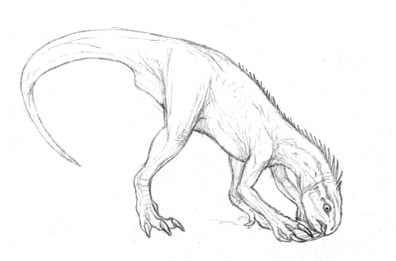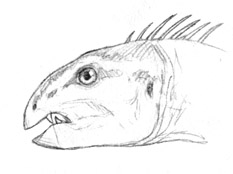
The caribbean winklecracker (Klinebergella
carcinovorax) is the northernmost of the kentropod species, seldom
exceeding a metre in length, and is common along the caribbean and Yucatan
coastlines of South American.
The winklecracker hunts along beaches, and at low tide out onto the reef flats, for the marine bivalves and snails that form most of its diet (although the species has been observed to eat fruit, and will frequently take any crabs it discovers whilst hunting).

The winklecracker is, in all aspects of its anatomy, a beach-comber. The wrists of kentropod viriosaurs (as opposed to those of maniraptors) are flexible enough that the winklecracker can dig, turn small coral boulders and debris, and handle prey---certainly a useful adaptation in the winklecracker's unique niche. Shells and flesh are gripped between four tusks (convergently similar to those of the Australian rhyncoraptors) then crushed by the powerful flattened beak and swallowed. In many individuals, fragments of more robust shells are swallowed to act as gizzard stones.
This combination of kentropod and general dinosaurian features - beak, hands, and gizzard - has enabled the winklecracker to occupy a niche no animal in Home-Earth has colonised---that of a large shore-dwelling molluscivore. Home-Earth shorebirds, for example, would not be capable of bearing the extra weight of shell and still be able to fly efficiently, and other species lack the crushing beak, and digging adaptations, that make a diet of large shelled molluscs possible.
Mainland-dwelling Winklecrackers usually live in small family groups. Those on islands and in more marginal habitats tend towards more solitary behaviour.